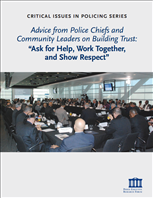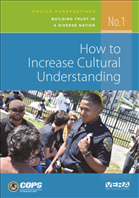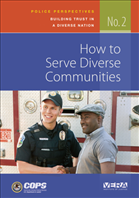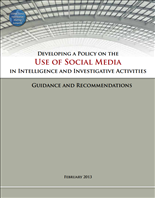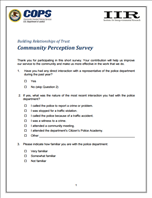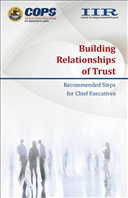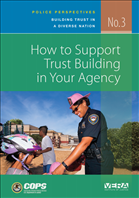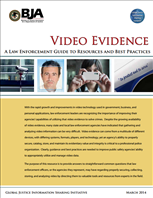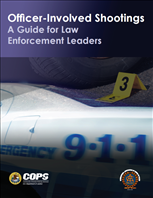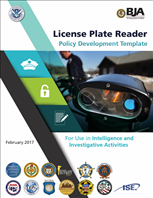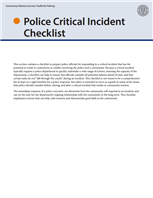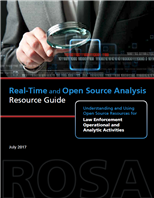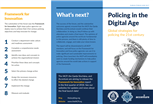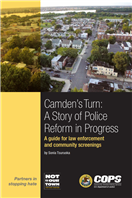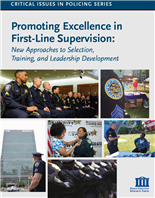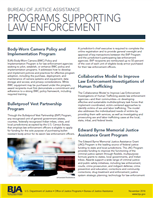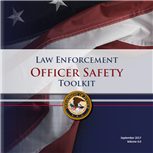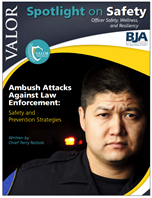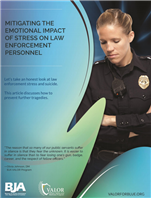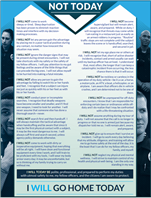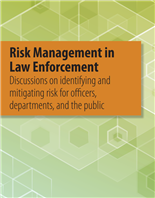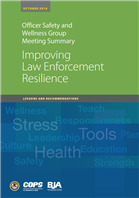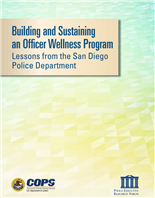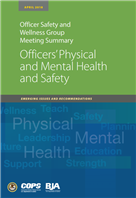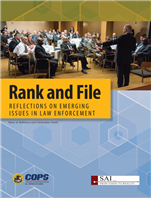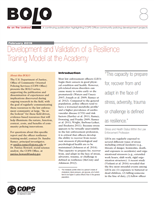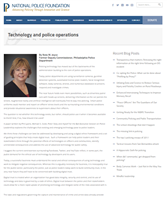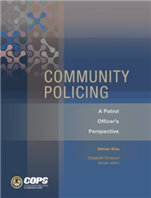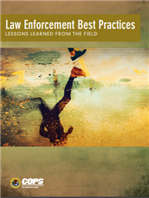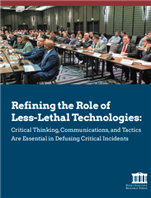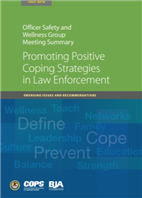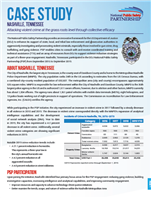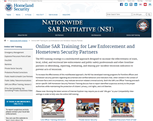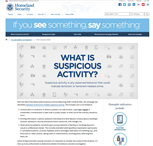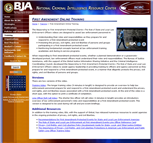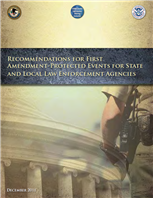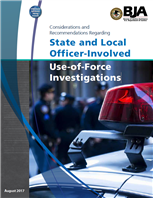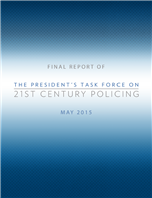Toolkit: Officer and Community Wellness Resources for Law Enforcement
Advice from Police Chiefs and Community Leaders on Building Trust: “Ask for Help, Work Together, and Show Respect”
PERF gathered chiefs and community members to hold discussions about issues of force and the level of trust in the police in communities. This document is a compilation of discussions from that meeting and summarizes key observations and strategies for improving relationships between police agencies and the communities they serve.
How to Increase Cultural Understanding
Recognizing the vital importance of trust to community cooperation, public safety, and national security, the Vera Institute worked with the Office of Community Oriented Policing Services to research and write this three-part series, which provides practical, field-informed guidance for creating positive, productive relations with all members of our multi-racial, multi-ethnic American population. To engage with their communities, law enforcement must understand their needs and concerns. This guide explores the history of law enforcement's relations with African Americans and offers strategies for overcoming past mistakes, building trusting relationships, and using mediation and other means for increasing dialogue and reducing tension after contentious incidents.
How to Serve Diverse Communities
Recognizing the vital importance of trust to community cooperation, public safety, and national security, the Vera Institute worked with the Office of Community Oriented Policing Services to research and write this three-part series, which provides practical, field-informed guidance for creating positive, productive relations with all members of our multi-racial, multi-ethnic American population. Law enforcement faces many challenges in building relationships with new immigrants, teenagers, and transgender communities. This guide provides practical guidance for overcoming language and cultural barriers, promoting dialogue with teens, developing anti-gang strategies, establishing youth mentorship programs, and understanding the safety concerns of the transgender community.
Nobility of Policing
FranklinCovey’s highly interactive Policing at the Speed of Trust program helps individuals in your organization identify and address “trust gaps” in their own personal credibility, in their relationships at work and in the community. Using examples based on their current work and focusing on real-world issues rather than theories or academic models, participants in the Policing at the Speed of Trust program will contribute to high trust in the organization
Fair and Impartial Policing
Fair & Impartial Policing®, LLC is the #1 provider of implicit-bias-awareness training for law enforcement in North America. The state-of-the-art Fair & Impartial Policing® training program is about how the mind works. There is no finger-pointing or blame. Instead, the program discusses how implicit biases can impact well-intentioned individuals outside their conscious awareness. A key strength of the program is its ability to reduce the defensiveness around this topic that many law enforcement officers may bring into the classroom.
VALOR Website
In 2010, the U.S. Department of Justice, Bureau of Justice Assistance created the VALOR Program to help prevent violence against law enforcement officers and ensure officer resilience and survivability following violent encounters during the course of their duties. VALOR was developed to address the increase in ambush-style assaults that have taken the lives of many law enforcement officers in recent months. VALOR provides critical nationwide training and technical assistance to sworn state, local, and tribal law enforcement officers through a variety of delivery mechanisms and conducts and disseminates analysis of violent encounters in various forms, including after-action reviews and lessons learned publications. Training covers topics including how to anticipate and survive a violent encounter by using "The Deadly Mix" framework (officer, offender, and the circumstances that brought them together), techniques for identifying concealed weapons and/or armed gunmen, high-risk tactical considerations (e.g., active shooters, hostage), and specific threat groups and violent criminals.
Developing a Policy on the Use of Social Media in Intelligence and Investigative Activities
The advent of social media sites has created an environment of greater connection among people, businesses, and organizations, serving as a useful tool to keep in touch and interact with one another. These sites enable increased information sharing at a more rapid pace, building and enhancing relationships and helping friends, coworkers, and families to stay connected. Persons or groups can instantaneously share photos or videos, coordinate events, and/or provide updates that are of interest to their friends, family, or customer base. Social media sites can also serve as a platform to enable persons and groups to express their First Amendment rights, including their political ideals, religious beliefs, or views on government and government agencies. Many government entities, including law enforcement agencies, are also using social media sites as a tool to interact with the public, such as posting information on crime trends, updating citizens on community events, or providing tips on keeping citizens safe.
Building Relationships of Trust: Community Perception Survey
A police department should distribute this survey to community members pre- and post-implementation of a building relationships of trust initiative.
Building Relationships of Trust: Recommended Steps for Chief Executives
A key component of successful policing is building collaborative, trusting relationships between law enforcement and the communities they serve, immigrant and minority communities. Developing these relationships allows law enforcement to more successfully address the challenges of crime control and terrorism prevention. The knowledge and insight that come from trust-based relationships between law enforcement and the community are critical because they allow law enforcement to distinguish between innocent cultural behaviors and behaviors indicative of criminal activity. The checklist on the following pages summarizes the recommended steps executives should consider when working to build relationships of trust with members of their community. As outlined in the document, this process must begin at the executive level but should be implemented department-wide. Implementation of these recommendations will enable agencies to more easily build and sustain those relationships. Each of the steps is outlined in more detail later in this document.
How to Support Trust Building in Your Agency
Recognizing the vital importance of trust to community cooperation, public safety, and national security, the Vera Institute of Justice worked with the Office of Community Oriented Policing Services to research and write this three-part series, which provides practical, field-informed guidance for creating positive, productive relations with all members of our multi-racial, multi-ethnic American population. This guide is a resource for agency leaders who want to build trust with the diverse communities they serve by adopting community policing practices and transforming their organizations. It provides practical strategies for diversifying their workforce, implementing and promoting community policing principles, and training officers in bias-free, culturally aware policing.
Video Evidence - A Law Enforcement Guide to Resources and Best Practices
With the rapid growth and improvements in video technology used in government, business, and personal applications, law enforcement leaders are recognizing the importance of improving their agencies' capabilities of utilizing that video evidence to solve crimes. Despite the growing availability of video evidence, many state and local law enforcement agencies have indicated that gathering and analyzing video information can be very difficult. Video evidence can come from a multitude of different devices, with differing systems, formats, players, and technology, yet an agency's ability to properly secure, catalog, store, and maintain its evidentiary value and integrity is critical to a professional police organization. Clearly, guidance and best practices are needed to improve public safety agencies' ability to appropriately utilize and manage video data. The purpose of this resource is to provide answers to straightforward common questions that law enforcement officers, or the agencies they represent, may have regarding properly securing, collecting, storing, and analyzing video by directing them to valuable tools and resources from experts in the field.
Officer-Involved Shootings: A Guide for Law Enforcement Leaders
Though few officers will be directly involved in a hostile shooting situation during their careers, many more may experience the impact of one; the effects of such events touch not only the officer involved, but the department and the community as well. Because of the gravity of officer-involved shootings, it is vitally important to ensure that the agency and its officers are prepared in advance for such an event. This guide is intended to provide guidance for preparing officers and departments prior to an officer-involved shooting, suggested incident scene actions and procedures, recommended procedures for conducting criminal and administrative investigations, suggestions for working with the media, and mental health and wellness considerations and procedures.
License Plate Reader Policy Development Template for Use in Intelligence and Investigative Activities
This document is a policy guidance resource designed specifically for law enforcement entities and fusion centers to assist them in their efforts to develop comprehensive privacy, civil rights, and civil liberties policies regarding the use of automated license plate readers (ALPRs or LPRs) in intelligence and investigative activities. Justice entities are turning to LPR technology to help solve crimes, recover abducted children, detect trafficking rings, and support terrorism investigations. However, when considering or implementing an LPR program, individual privacy, civil rights, and civil liberties must also be vigorously protected. Justice entities should therefore put in place appropriate policies and procedures to guard against possible errors and other potential problems.
BJA Body-Worn Camera Toolkit
The Body-Worn Camera (BWC) Toolkit was created by BJA as a resource for law enforcement agencies across the country and around the world. BWC programs can support law enforcement strategies to improve public safety, reduce crime, and strengthen relationships between police and the community. Comprehensive BWC programs are guided by policies that effectively incorporate research, promising practices, community input, and vital implementation considerations. This toolkit consolidates and translates the developing body of knowledge on BWCs for law enforcement, criminal justice professionals, advocacy organizations, and community members. This toolkit organizes frequently asked questions, resources, and other information by key topics areas, including research, policy, technology, and privacy.
Police Critical Incident Checklist
This section contains a checklist to prepare police officials for responding to a critical incident that has the potential to result in controversy or conflict involving the police and a community. Because a critical incident typically requires a police department to quickly undertake a wide range of actions, straining the capacity of the department, a checklist can help to ensure that officials consider all potential options ahead of time, and that certain tasks do not “fall through the cracks” during an incident. This checklist is not meant to be a comprehensive list of steps or a rigid timeline for a police response, but rather is intended to serve as a guide to many of the issues that police should consider before, during, and after a critical incident that results in community tension. The immediate response of a police executive can determine how the community will respond to an incident, and can set the tone for the department’s ongoing relationship with the community in the long-term. This checklist emphasizes actions that can help calm tensions and demonstrate good faith to the community.
Real-Time and Open Source Analysis Resource Guide
This document was developed by the National Network of Fusion Centers (NNFC), in partnership with the ODNI’s Office of Partner Engagement-Information Sharing Environment (PE-ISE), the U.S. Department of Homeland Security (DHS), the Federal Bureau of Investigation (FBI), and the associations represented on the Criminal Intelligence Coordinating Council (CICC), to assist law enforcement agencies and fusion centers in understanding the lawful and appropriate use of open source information, focusing on social media. It is designed to help law enforcement agencies and analytic personnel understand the potential tools and resources available to support law enforcement operational and analytic activities, while ensuring that related privacy, civil rights, and civil liberties concerns are addressed.
Policing in the Digital Age: Global strategies for policing the 21st century
The International Association of Chiefs of Police (IACP), in partnership with the Garda Síochána and Accenture, brought together 50 attendees from across the globe in Dublin, Ireland, for a high-level forum on 21st century policing in the digital age. Over two days of discussion and debate, attendees examined and compared current global policing approaches and evaluated progress towards an agile technology driven policing model that could meet the challenges of delivering public safety in a digitally disrupted age, and be applied to any police agency in any country at pace. The goal: to gain a deeper understanding of emerging 21st century and global policing models; to determine how technology in the digital age will support and transform policing’s mission; to design an adaptable pathway to global policing innovation; and to share recommendations with police agencies around the world.
Camden’s Turn: A Story of Police Reform in Progress
The film and this accompanying screening guide are a part of a project titled The Guardians: Stories of 21st Century Policing, a collaboration between Not In Our Town (NIOT) and the US Department of Justice’s Office of Community Oriented Policing Services (COPS Office). To access all available film resources and tools, visit NIOT’s online hub at www.NIOT.org/COPS.
Promoting Excellence in First-Line Supervision: New Approaches to Selection, Training, and Leadership Development
When PERF decided to hold a national conference on first-line supervision in police agencies, PERF members were asked to bring one of their top sergeants to the conference—a first-line supervisor who exemplified the qualities that agencies need to take on the challenges of modern-day policing. Fifty chiefs and sheriffs responded to the request. The sergeants and mid-level supervisors they brought to Washington, D.C. for the Critical Issues in Policing conference on April 3, 2018, were knowledgeable, articulate, and attuned to the important role they play in their agencies. They helped PERF understand how the role of first-line supervisors is changing, and what police and sheriffs’ departments need to do to keep pace with those changes. This report is intended to help refocus the spotlight on the importance of first-line supervisors to achieving effective, constitutional policing.
BJA's Programs Supporting Law Enforcement
BJA's programs available to support law enforcement
Law Enforcement Officer Safety Toolkit Booklet
This toolkit, developed by the U.S. Department of Justice, provides resources to improve the efforts of state, local, and tribal law enforcement personnel to increase officer safety and wellness.
Ambush Attacks Against Law Enforcement: Safety and Prevention Strategies
On May 15, 2017, the Federal Bureau of Investigation released the 2016 preliminary statistics for Law Enforcement Officers Killed in the Line of Duty . These statistics show that 66 law enforcement officers were feloniously killed in the line of duty and that 17 of these officers were killed in ambush attacks. Ambush attacks also were responsible for multiple serious injuries to officers and others. This article provides strategies to prevent ambush attacks and keep officers safe if attacked.
Mitigating the Emotional Impact of Stress on Law Enforcement Personnel
This publication examines the emotional impact of stress and trauma on law enforcement officers. When stress compromises an officer's ability to effectively serve and protect, learning to mitigate these effects helps both the officers and the community.
Not Today Poster 8.5 X 11
This poster emphasizes mental preparations and actions for law enforcement officers to take to help ensure that they stay safe.
Risk Management in Law Enforcement: Discussions on Identifying and Mitigating Risk for Officers, Departments, and the Public
In the course of executing their duties, law enforcement agencies are vulnerable to costly lawsuits by officers and community members for claims of misconduct, harm, or violation of rights - lawsuits that can undermine not only the financial security of the agencies but also the well-being of the officers and the public they serve. To help law enforcement identify and minimize these risks, the COPS Office and Strategic Applications International (SAI) convened a forum that included representatives of labor unions, local government, law enforcement agencies, and the community. This report, which details the discussions of that forum, covers all aspects of this critical subject, including departmental leadership's role, recruitment policies, and police-community relations. Readers will also find tools for sharing risk management and a description of the roles and responsibilities of government, risk managers, insurers, unions, and the community in this effort. The appendices provide a summary of the forum's recommendations and a list of resources for risk management.
Officer Safety and Wellness Group Meeting Summary: Improving Law Enforcement Resilience - Lessons and Recommendations
Since 2011, the COPS Office and the Bureau of Justice Assistance (BJA) have raised awareness, increased knowledge, and promoted practices that support the safety and well-being of law enforcement officers through the Officer Safety and Wellness (OSW) Group. In October 2016, the OSW Group brought law enforcement practitioners and subject matter experts together to discuss promising practices for supporting officer resilience. Resilience - the ability not only to recover emotionally from traumatic events but to withstand day-to-day work-related stress - is critical to the physical and psychological health of all law enforcement officers. In addition to summarizing the group's discussions at the October meeting, this report contains case studies of the emotional impact of mass casualty events on first responders in Dallas, Texas; Orlando, Florida; and San Bernardino, California. The report also provides recommendations for preparing officers for traumatic events and strategies for supporting overall resilience through physical and emotional health.
Building and Sustaining an Officer Wellness Program: Lessons from the San Diego Police Department
Law enforcement agencies around the country are recognizing the importance of monitoring and tending to employees' physical and mental health and wellness. This publication discusses the establishment and operation of a dedicated unit at the San Diego Police Department with the goal of promoting a department-wide culture of wellness. Working toward this goal will also help the department better serve its community. The Police Executive Research Forum, working with the SDPD under a cooperative agreement from the COPS Office, identified lessons learned and recommendations that will help guide other local agencies that may be interested in setting up similar programs.
Officers' Physical and Mental Health and Safety: Emerging Issues and Recommendations
The OSW Group's April 2018 meeting expanded on previous discussions of ways to support officers' emotional health and organizational wellness. This meeting focused particularly on line-of-duty deaths in felonious assaults as well as in accidents, mental health and suicide, and crisis hotlines and other programs. Families, community members, and others can contribute to the important work that is needed in this area by supporting officer safety and wellness, participating in conversations and programming, and working to reduce the negative stigma surrounding mental health issues.
Rank and File: Reflections on Emerging Issues in Law Enforcement
In August 2017, 40 rank-and-file officers met for a roundtable to discuss their roles in implementing their agencies' community policing policies and operations. The officers came from departments across the country and explored a wide range of issues from the viewpoint of those who work on the ground. The meeting provided insights and recommendations for ways in which officers, law enforcement leaders, and communities can work together to reduce crime - in particular illegal immigration, drug trafficking, and violent crime. They also discussed the need to support officer morale, safety, and wellness and explored emerging issues such as the growing opioid epidemic, providing forthright assessments of the current state of policing. This report intends to capture the experiences, opinions, and ideas of the participating officers; and, it should be noted, the officers’ quotes that follow do not presume to speak for the more than 800,000 agents of law enforcement working nationwide. By including and emphasizing the views and impressions of the rank-and-file, this publication offers a glimpse into the daily routine of a unique and demanding profession.
Development and Validation of a Resilience Training Model at the Academy
The U.S. Department of Justice, Office of Community Oriented Policing Services (COPS Office) presents the BOLO series, supporting the publication and dissemination of experiences and implications discovered during ongoing research in the field, with the goal of regularly communicating these resources to the law enforcement community at large. “Be on the lookout” for these field-driven, evidence-based resources that will help illuminate the nature, function, context, costs, and benefits of community policing innovations.
New Orleans Police Department's Ethical Policing is Courageous (EPIC) Peer Intervention Program Webinar
EPIC is a program developed by the NOPD in an effort to educate and support their officers in the practice of peer intervention. Through EPIC, the NOPD trains members of its department to identify and safely intervene when they believe a person is at risk for doing something that would harm themselves and/or others. This peer approach to 'policing' one another has proven to be effective for the NOPD in preventing harm and promoting officer wellness. The goal of this webinar is to highlight and bring awareness to this proactive, team-focused program as a solution to the officer safety issues that law enforcement faces today. This webinar will explore the efforts that went into gaining support for the program, steps for implementation, challenges faced, and lessons learned.
Technology and police operations
This blog post expands on the ideas of digital trust and ethics presented in a paper written by Phil Lyons, Michael S. Scott, Peter Sloly and Nola Joyce for the BJA Executive Session on Police Leadership that explores the challenges that existing and emerging technology pose to police leaders.
Community Policing: A Patrol Officer's Perspective
This guide is intended to help frontline police officers—first responders—better understand how to provide leadership, engage in effective partnerships, and solve problems in the communities they serve. The guide includes information regarding what factors can be, to some degree, controlled and what strategies can be implemented in a practical way to enhance community policing.
Law Enforcement Best Practices: Lessons Learned from the Field
This guide was developed by experts and practitioners from across the country to provide practical advice to three primary audiences: (1) new law enforcement executives and law enforcement leaders, who need to understand key challenges facing their communities and agencies; (2) seasoned law enforcement executives and law enforcement leaders in communities where these issues have come to the forefront; and (3) personnel who work for chiefs or sheriffs and have been asked to work on the agency’s approach to one or more of these issues.
Refining the Role of Less-Lethal Technologies: Critical Thinking, Communications, and Tactics Are Essential in Defusing Critical Incidents
The report is a result of the collaborative conference held by the Police Executive Research Forum and the Los Angeles Police Department that brought together approximately 225 police chiefs and sheriffs, tactical trainers, and other law enforcement personnel, as well as industry leaders in the field of less-lethal tools to dissect the challenges that police officers face in many potential use-of-force situations, and to identify new approaches for meeting those challenges.
Officer Safety and Wellness Group Meeting Summary: Promoting Positive Coping Strategies in Law Enforcement
In July 2019, the Officer Safety & Wellness Group expanded on discussions of methods of supporting emotional health and organizational wellness, focusing particularly on alcoholism, substance abuse, and coping strategies officers might use to help them deal with the stressors of the job. This document serves as an official summary of that meeting and seeks to provide readers with critical information, promising practices, and recommendations from law enforcement leaders and SMEs from across the nation.
PSP Case Study: Nashville, Tennessee
In March 2016, the US Department of Justice (DOJ) selected Nashville, Tennessee to be a part of the National Public Safety Partnership (PSP). The PSP is a DOJ-wide pilot program that enables cities to consult with and receive coordinated training and technical assistance (and an array of resources) from DOJ to support violence reduction strategies as part of a three-year engagement. This document serves as a case study of PSP site Nashville.
Analysis Toolkit
The Analysis Toolkit was developed with support of the U.S. Department of Justice (DOJ), Bureau of Justice Assistance (BJA) as a clearinghouse for publicly available crime and intelligence analysis resources. Users can explore existing resources, refine current approaches, and discover new points of contact.
Online SAR Training for Law Enforcement and Hometown Security Partners
To increase the effectiveness of its multifaceted approach, the NSI has developed training programs for frontline officers and hometown security partners regarding documented and verified behaviors and indicators that, when viewed in the context of all known facts and circumstances, may indicate terrorism-related criminal activity.
If You See Something, Say Something: What Is Suspicious Activity?
With the help of the Nationwide Suspicious Activity Reporting (SAR) Initiative (NSI), the campaign has identified indicators of terrorism-related suspicious activity. We can all help keep our communities safe by paying attention to our surroundings and reporting suspicious activity to local law enforcement or a person of authority.
First Amendment Online Training
The Bureau of Justice Assistance, with the support of the Global Justice Information Sharing Initiative and the Criminal Intelligence Coordinating Council, developed the Responding to First Amendment-Protected Events—The Role of State and Local Law Enforcement Officers videos to assist agency leadership in providing training to officers and agency personnel as they prepare for and respond to a First Amendment-protected event, in a manner that diligently protects the privacy, civil rights, and civil liberties of persons and groups.
The Role of State and Local Law Enforcement at First Amendment Events Reference Card
This reference is designed to serve as a pocket-sized reference card for line officers who are responding to a First Amendment-protected event and provides an overview of their roles and responsibilities, as well as an overview of the rights of the participants of First Amendment-protected events.
Recommendations for First Amendment-Protected Events for State and Local Law Enforcement Agencies
As articulated in the United States Constitution, one of the freedoms guaranteed by the First Amendment is the right of persons and groups to assemble peacefully. Whether demonstrating, counterprotesting, or showing support for a cause, individuals and groups have the right to peacefully gather. Law enforcement, in turn, has the responsibility to ensure public safety while protecting the privacy and associated rights of individuals. To support agencies as they fulfill their public safety responsibilities, the Criminal Intelligence Coordinating Council (CICC) developed this paper to provide guidance and recommendations to state and local law enforcement officers in understanding their role in First Amendment-protected events. This paper is divided into three areas, designed to provide in-depth guidance for law enforcement.
Considerations and Recommendations Regarding State and Local Officer-Involved Use-of-Force Investigations
The Considerations and Recommendations Regarding State and Local Officer-Involved Use-of-Force Investigations resource sets forth recommendations and considerations for municipal, county, and state law enforcement officials tasked with ensuring accountability for critical use-of-force incidents that result in death or serious bodily injury to any party. It is intended to be used prior to a critical use-of-force incident to identify and implement recommendations, address issues, and better equip agencies to effectively respond to use-of-force investigations. It is designed to follow existing laws, regulations, and statutes, and agencies should review their operating structures to ensure adherence to governing processes as they review the considerations and recommendations identified in this resource.
Final Report of the President's Task Force on 21st Century Policing
On December 18, 2014, President Barack Obama signed an executive order establishing the Task Force on 21st Century Policing. The President charged the task force with identifying best practices and offering recommendations on how policing practices can promote effective crime reduction while building public trust. This executive summary provides an overview of the recommendations of the task force, which met seven times in January and February of 2015. These listening sessions, held in Washington, D.C.; Phoenix, Arizona; and Cincinnati, Ohio, brought the 11 members of the task force together with more than 100 individuals from diverse stakeholder groups—law enforcement officers and executives, community members, civic leaders, advocates, researchers, academics, and others—in addition to many others who submitted written testimony to study the problems from all perspectives. The task force recommendations, each with action items, are organized around six main topic areas or “pillars:” Building Trust and Legitimacy, Policy and Oversight, Technology and Social Media, Community Policing and Crime Reduction, Officer Training and Education, and Officer Safety and Wellness.
Precision Policing Initiative (PPI) Toolkit
This toolkit shares information and resources from the COPS Office Precision Policing Initiative (PPI) and other collaborative efforts to provide safer neighborhoods by leveraging partnerships, analysis, research, and technology. The information and resources shared in this toolkit can help law enforcement agencies learn more and determine whether similar activities could benefit their agencies
